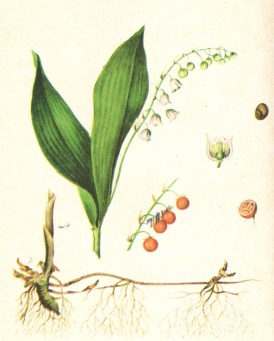Lily of the valley is a perennial herbaceous plant with a thin, creeping, branched horizontal rhizome that facilitates vegetative reproduction. The plant develops two elliptical, entire, glabrous basal leaves, and a flower stalk emerges between them with a one-sided raceme of fragrant, white, nodding six-toothed flowers. The fruit is a red, fleshy berry. The plant is bitter and poisonous. It blooms in May–June. There are three species (or varieties), all with medicinal properties.

May Lily of the Valley — Convallaria majalis L.The perianth is shaped like a slightly cut bell, and berries rarely develop. It has the widest range, occurring in forest and forest-steppe zones of the European part of Russia up to the Southern Urals. It is almost absent in Siberia. The largest populations are found in spruce and mixed forests with grassy cover, in green moss areas, often alongside wintergreen, blueberry, and ferns. It thrives abundantly in areas of cleared spruce forests and among shrubs. Although it is present in damp pine forests, it is less abundant. In southern regions, especially in Bashkiria, it is common in deciduous forests. In the steppe zone, it occurs rarely and only in river valleys. May lily of the valley is harvested in the largest quantities compared to other species.
Caucasian Lily of the Valley — Convallaria transcaucasica Utk.This species has a perianth shaped like a widely open bell with slightly turned-back lobes. It grows in mountain forests, on the southern coast of Crimea, and in the western regions of the Caucasus. It is widely harvested.
Keiskei Lily of the Valley — Convallaria keiskei Miqu.This species has a bell-shaped perianth and is distinguished by very vigorous growth; berries develop abundantly. It grows in deciduous forests in the Far East, especially abundantly after logging and forest regeneration. In more northern areas, it is also found in spruce forests. It occupies all of Primorye and the Amur region, Sakhalin, and the Kuril Islands, extending westward into Dauria as far as Lake Baikal. It can be harvested industrially in the Far East.
Harvesting and Processing
Three types of raw materials are harvested:
- Herba Convallariae: Leaves with inflorescences and separate leaves (inflorescences must make up at least 5%). Collection lasts for 25 days due to the extended flowering phase. After flowering, leaf activity decreases.
- Folium Convallariae: Young leaves collected before flowering, when they are most active.
- Flores Convallariae: Flowering stalks, cut short, or individual flowers. These are dried quickly in dryers at 50–60°C or in attics away from sunlight.
All parts of the plant contain cardiac glycosides — cardenolides.
Glycoside Composition
The accumulation of glycosides in lily of the valley varies by vegetative phase and plant parts. Leaf activity is highest before bud formation (333 LED), decreases during flowering (272 LED), and drops further after flowering (145 LED). Flowers yield 572–642 LED, mature fruits 362 LED, and rhizomes peak in activity in autumn (133 LED).
The total glycoside composition is complex. Paper chromatography has identified 8–11 glycosides in the leaves and flowers. The cardenolide profile of the three species is qualitatively similar but quantitatively different. The main cardiac glycoside is convallatoxin, a monoside that breaks down into the aglycone strophanthidin and the sugar rhamnose. Leaves contain about 50% convallatoxol, which splits into strophanthidol and rhamnose. Other glycosides include desglucocheirotoxin, convalloside (strophanthidin, rhamnose, and glucose), and trace amounts of additional compounds. A particularly interesting glycoside is locundjeside, whose aglycone has a hydroxyl group at position C11. Another glycoside, convallarin, belongs to the saponins and irritates the intestinal mucosa, causing a laxative effect, and stimulates the kidneys.
Medicinal Use:
A 1:10 tincture of Herba Convallariae in 70% alcohol is prescribed in doses of 15–20 drops. Young dried leaves are used to prepare a dry extract in powder or tablets (0.1 g each, taken 2–3 times daily). Korglikon, a solution of total glycosides from lily of the valley leaves, is produced in 1 ml ampoules containing 0.6 mg of korglikon. A 0.03% solution of convallatoxin glycoside is also available in 1 ml ampoules. Additional preparations, such as lily of the valley drops with valerian, are produced. The tincture is used as a cardiac remedy. Lily of the valley does not exhibit cumulative properties.
